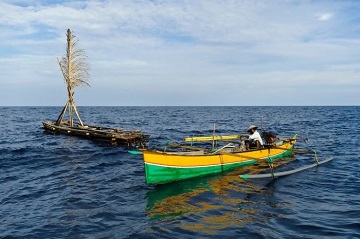Anchored Fish Aggregating Devices (FAD) for Artisanal Fisheries in Indonesia: Benefits and Risks

The use of deep sea rumpon, a type of Fish AggregatingDevice (FAD), has been utilized in Indonesia, particularly in eastern Indonesia waters since long time ago. Deep sea rumpons were introduced for fishermen in Pacitan district, East Java province in early 2005. The use of rumpon for fishing activities has improved the effectiveness and efficiency if compared with other fishing gear. Fishing activities using this fishing gear and trawls have been recognized and grow rapidly since the introduction of FADs. The production of landed catches at the Tamperan Beach Fishery Port, Pacitan regency, are increasing every year.
More and more deep rumpon are anchored by fishermen, until 2014 their total number were approximately 250 units. The use of FADs and excessive fishing activities is feared will disrupt the sustainability of fish resources in the waters and will ultimately threaten the sustainability of existing fishing business. Simple or advanced FADs are left drifting in deep waters to help offshore, artisanal and industrial fleets catch big pelagic fish, mainly tuna. Hundreds of simple, traditional types of drifting FADs are used by each large, modern tuna purse seiner operating in certain areas. It has been observed that the use of FADs often alters the exploitation of the resources with more juvenile stocks of fish were being taken when fishing around the FADs.
Referring to the such problem, a group of experts of the Department of Water Resources Utilization (PSP) of the Faculty of Fisheries and Marine Sciences of Bogor Agricultural University (FPIK IPB) implemented the research program on the utilization of Rumpon and its impact on the sustainability of fish resources. The groups were Muhamad Riyono Edi Prayitno, Domu Simbolon, Roza Yusfiandayani and Budy Wiryawan.
Roza said Rumpon or Fish Aggregating Devices (FADs) are a tool in fishing activities used to collect fish so that it is easier to catch. Anchored FADs are an important tool for the development of sustainable artisanal and small-scale commercial fisheries that provide food and livelihoods to coastal communities. FADs make a valuable contribution towards food security by helping meet increasing demand for fish influenced by population growth and the effects of climate change. She said the use of FADs has provided many benefits for increased fishery production, on the other hand its use resulted in some negative impacts to the sustainability of resources in the waters.
"The use of FADs can increase production per ship when the pressure on resources is still low. Industrial FADs are used in large numbers all over the high seas, while artisanal anchored FADs are usually located near coastal fishing communities and are important for local food security, nutrition and livelihoods. Some countries in Southeast Asia are embarking on anchored FAD programmes to boost fish production and to increase food security. But it can encourage over-fishing if the fishing effort is too high, "she said.
Ffurther she described that today there are thousands of FADs in use worldwide for industrial handline, purse seine, and pole and line fisheries. There are three basic designs for anchored FADs – the spar buoy and the Indian Ocean FAD as well as the far more common artisanal FADs made from local materials such as bamboo and coconut fronds. The analysis shows that while anchored FADs can bring important benefits to fishing communities in terms of food security and livelihoods, it is necessary to properly plan the intervention as there are many pitfalls which can cause programmes to become unsustainable, resulting in losses for both governments and fishing communities. FADs can also be a source of pollution, and can obstruct navigation and other fishing activities, leading to social conflict.
The results showed that the use of FADs had a positive impact in increasing the chances of successful operation of seine pukat fishing and fishing rods. However, in the last decade or so, FADs for both artisanal and commercial/industrial fisheries have proliferated in Indonesia. In some areas this has caused concern about the potential negative impacts on fisheries and the marine environment. There is concern that pelagic species that aggregate at FADs can be easily over exploited. Fishermen should be encouraged to collect catch and effort data, so that fisheries managers can monitor the health of fish stocks. Purse seine associated sets, which are sets made on floating objects, including Fish Aggregating Devices (FADs), leading to a cascade of effects. The “ecological trap” hypothesis suggests that tuna and other fish can be trapped within networks of drifting FADs, which could alter the migratory paths of such fish and therefore affect characteristics such as growth and reproduction. Methods used in the open sea may not be suitable for fishing around the FAD. It has been observed that the use of FADs often alters the exploitation of the resources with more juvenile stocks of fish were being taken when fishing around the FADs. (Wied)



